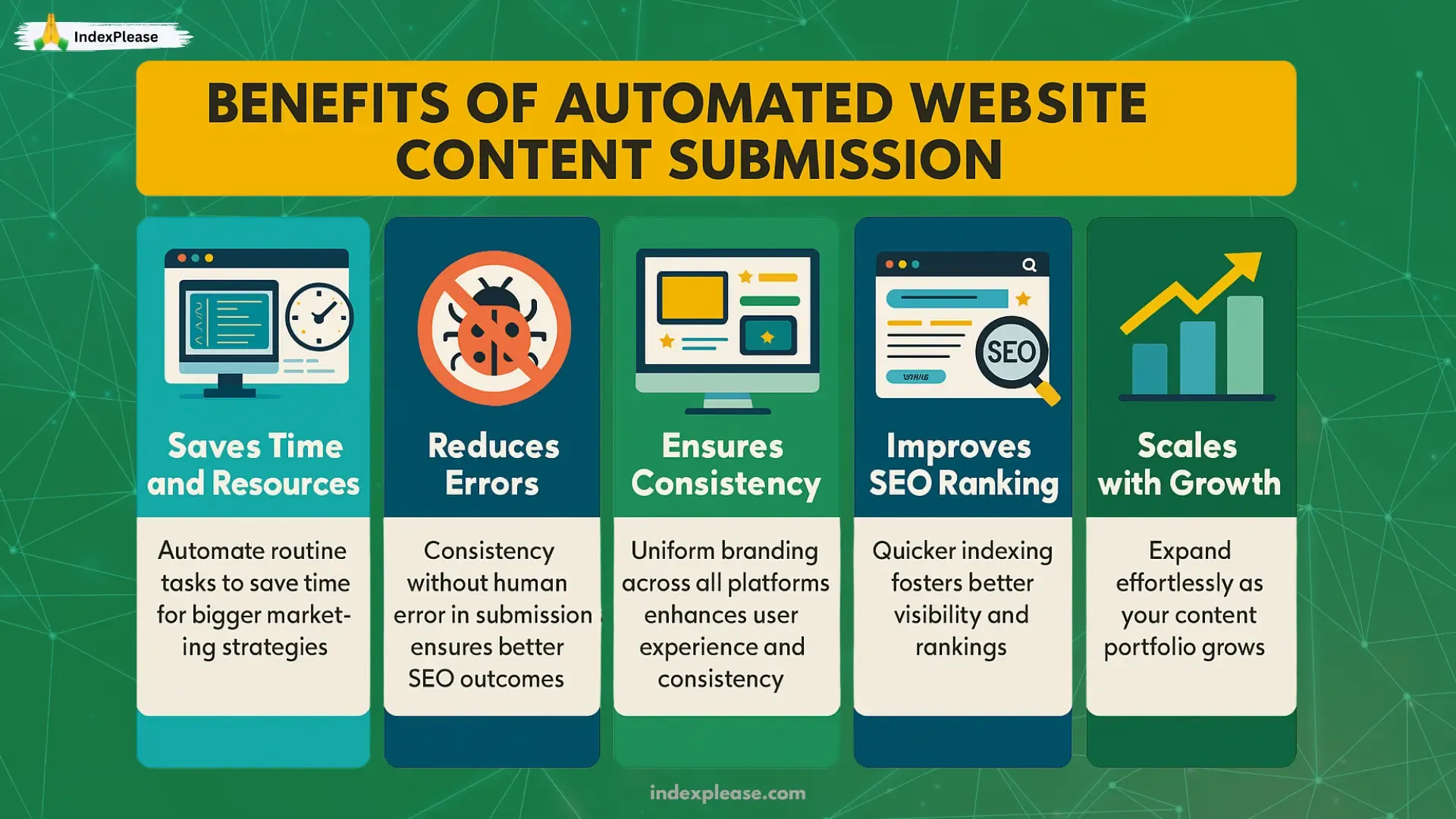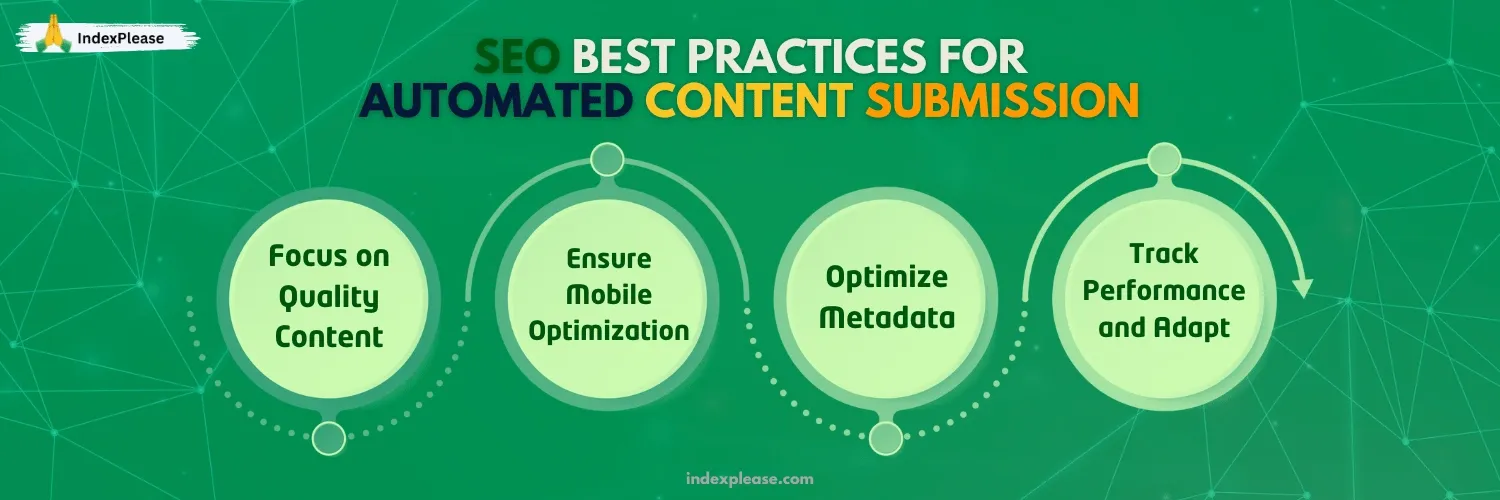
Automating Content Submission for Efficient Indexing
Consider creating very high-quality and valuable content that is never seen by anyone because an index has not been created for it. Frustrating, right? In today’s digital age, competition is everything. The sooner your content gets indexed, the better it is for traffic and results. However, there are downsides. Having to monitor submission manually is inefficient and tiresome. This is where automated content submission saves the day.
Marketers, website owners, and SEO professionals can save time and guarantee that their content reaches target audiences in the least possible time. If you manage a blog or an online shop, automation will ensure that you are ahead of your competitors with little effort. Regardless of whether you are managing an e-commerce platform or running a corporate chain, it is much easier to achieve the set goals using automation.
Let’s look at how your website can reach its full potential with automated content submission.
What is Automated Content Submission?
Automated content submission is when software is used for the submission and distribution of the content of a website on platforms, directories, or even on search engines. Because the entire process is automated, it saves time and reduces the chances of errors.
Whether posting blog entries, revising product information, or sharing site maps, automation minimizes redundant work and maximizes exposure to the content.
Why Is Efficient Indexing Important?
Indexing refers to how search engines like Google or Bing comprehend the structure and content of a site. Without proper indexing:
Your website may remain invisible in search results.
Newly added content might not appear promptly.
It becomes harder to build domain authority.
Efficient indexing makes sure that your website is functional, current, and properly configured for user queries. The automated submission of content is very important in speeding up this process.
Benefits of Automated Website Content Submission

Saves Time and Resources
Submitting content manually may require dozens of hours of labor. Automating the workflow allows the members of the team to work on business plans, developing designs, and dealing with the audience.
Reduces Errors
Human errors, like submitting outdated URLs or missing metadata, can impact performance. Automation tools ensure submissions are accurate and complete.
Ensures Consistency
Automation ensures that content is distributed uniformly across platforms, maintaining branding and tone.
Enhancement of Search Engine Ranking
The quicker and more precise the indexation is, the more advantageous visibility and improved ranking in search results will likely be achieved, particularly for fiercely contested keywords.
Scalable For Growing Businesses
As companies expand, it can be a hassle to control the numerous contents of different sites or accounts connected to one business organization. Automation makes scaling effortless.
Steps For Effective Automation Of Submission of Material
Automating processes can be done effectively with a coherent and clear approach outline. Below are actionable steps to streamline content submission for efficient indexing:
Set Clear Goals for Automation
Before implementing any tools or workflows, define what you hope to achieve. Whether your focus is faster indexing, consistent branding, or reaching multiple directories simultaneously, having clear goals will guide your process.
Select the Right Platforms
Different types of content need different submission platforms:
Blog Content: Set up automatic posting to social media, blog directories and promote through RSS slices.
Product Pages: Use integrations with eCommerce systems for search engines and affiliate networks to catch up with product changes.
Multimedia: Automatically publish videos to YouTube, Vimeo, or video-oriented search engines.
Create and Submit Sitemaps

A sitemap is essential to assist search engines looking to browse and index your website. Most CMS, particularly WordPress, can create and send sitemaps with the help of plugins.For added efficiency:
You can also use Google Search Console for monitoring your sitemap submission status.
Automatic sitemap submission every time new content is added.
Leverage RSS Feeds
RSS feeds notify readers and search directories when new content is available. Automating your feed ensures that subscribers and indexing bots are promptly updated. RSS also simplifies syndication across content platforms, making it a useful tool for bloggers and publishers.
Integrate APIs for Direct Indexing
There are APIs, such as Google’s Indexing API, which allow users to skip the queue and facilitate faster indexing. This is important for users with highly volatile or extremely important information. Steps to leverage APIs include:
Enabling the API: Integrate Google Indexing API with your CMS or custom scripts.
Automating Submissions: Set up automated workflows that push updates instantly to Google.
Monitor and Analyze Results
Automating isn’t a reason to completely ignore what you’ve done. It is still essential to review the impact of your efforts to make sure your submissions are performing as intended.Key metrics to track include:
Submission Success Rates: Identify errors or missed platforms.
Indexing Speed: Measure how quickly content appears in search results.
Engagement Metrics: Analyze traffic and user behavior post-submission.
Solutions To Consider For Automated Publication Of Content Challenges
In the world of automation, everything is accelerated but error prone. That is why businesses will still encounter challenges when trying to automate workflows. Recognizing these challenges allows for smoother execution:
Cost of Tools
Some advanced tools that offer automation come at a price, which can be unreasonable for small and new businesses. Focus on tools that have affordable or no-cost scalable options.
Risk of Over-Automation
Excessive automation can result in spammy practices, like duplicate submissions or irrelevant content placements. To avoid this:
Use reputable platforms for submissions.
Maintain content quality and relevance.
Follow SEO best practices to avoid penalties.
Learning Curve
New tools and workflows often require training. To overcome this challenge:
Start with beginner-friendly automation tools.
Invest in training sessions for your team.
Gradually scale up automation processes to match your team’s skill set.
SEO Best Practices for Automated Content Submission

Automation works best when aligned with SEO guidelines. Ensure your strategy incorporates these best practices:
Focus on Quality Content
Always prioritize quality over quantity. Even if content was crafted faster, it will ultimately undermine your site’s ranking and reputation.
Ensure Mobile Optimization
With mobile-first indexing, search engines prioritize mobile-friendly websites. Ensure that automated submissions accommodate responsive designs and mobile-ready metadata.
Optimize Metadata
Metadata such as titles, descriptions, and tags should be updated consistently through automated tools to ensure content relevance.
Track Performance and Adapt
Use analytics tools to measure the performance of automated workflows. If submissions are failing or underperforming, refine strategies and fix errors.
How Automated Content Submission Transforms Modern SEO
Modern SEO works around speed, efficiency, and accuracy. Automated content submission improves all of those things, making sure that your website is visible, accessible, and competitive. Businesses are able to shift their focus on tactics and attraction by streamlining redundant work processes.
With a well-planned automation strategy, you are able to save time while also bringing the indexing capabilities of your website to its fullest potential. It does not matter if you are a digital marketer, eCommerce store owner, or a blogger; keep up with the changing times of SEO with automation.
IndexPlease enables you to automate indexing in a flash.

Ensure that your content is indexed in your desired time frame, links are submitted manually (which as you know, can be inconsistent, tedious, and time-consuming), or crawled automatically. IndexPlease enables you to eliminate the hassle of time tracking and bookkeeping, ranking your content on search engines first. IndexPlease enables you to forget about manual tracking and submission, allowing your website to maintain a competitive advantage. As a result, your content gets indexed instantly with every submission. Whether you are a blogger, eCommerce store owner, or a digital marketer, using IndexPlease will automate your workflows, resulting in smoother and high-efficiency processes.
Conclusion
For those looking to improve their digital footprint, automated content submission is no longer a luxury - it’s a necessity. Automation guarantees results by decreasing human effort, human error, and increasing indexing speed.
To achieve the most from automation, start with setting reasonable objectives, using the right tools, and ensuring that the automation measures you take are compatible with best SEO practices. Start implementing automated content workflows and, as a consequence, enjoy increased website visibility, traffic and engagement.
FAQs
- What is automated content submission, and how does it work?
Automated Content Submission is the use of tools or software to submit, distribute and publish website content online automatically without any manual effort.It automates mundane tasks like updates or sharing blogs, or even direct indexing through APIs which saves time and maintains quality.
- Why is automated content submission beneficial for SEO?
Automation accelerates the entire indexation process so that your content is visible and reachable by the audience or clients. You have improved visibility, better ranking in search engines, and the ability to reach the audience faster.
- What different types of content can be automated?
Blog posts and articles along with product pages, videos, multimedia, sitemaps, and almost anything else can be automated. Automation tools primarily work with RSS feeds, APIs, and CMS so all updates are made quickly and effortlessly.
- How does automation reduce errors in content submission?
Automation reduces human made mistakes such as submitting irrelevant content or incorrect URLs along with missing metadata and content replication. Submission of content can be automated to ensure that it is accurate and current information for the audience.
- What problems are prevalent when automating content submission?
Some challenges include tool costs, over-automation risks (leading to spam), and the learning curve associated with new tools. Common issues include a constant lack of focus on the quality of submissions and using poorly made tools. These issues can be easily fixed with regular adjustments.
- How can I automate the content submission for my website?
For the first step, make sure to construct a sitemap, activate RSS feeds and think about adding APIs like Google’s indexing API for quick submission. Use tools or plugins that will automate submissions, track results through analytics, and adjust strategies for optimization.